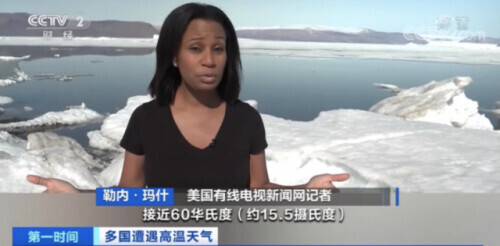According to CNN reported on the 20th, affected by the recent rare high temperature weather in many European countries, the ice sheet covering Greenland, the world's largest island, is melting in a large area, and from July 15 to 17 alone, the daily loss of ice has reached about 6 billion tons, which is enough to fill 7.2 million Olympic-size swimming pools.
The Greenland Ice Sheet is the second largest ice sheet in the world, covering an area of nearly 1.8 million square kilometers, second only to the Antarctic Ice Sheet, with average annual temperatures below 0 degrees Celsius. Generally speaking, June to early September is the melting season of the Greenland ice sheet. But unusually warm weather in recent days has led to an acceleration in the melting of Greenland's ice.

CNN reporter René Marsh: Today (19th) Greenland is very hot, close to 60 degrees Fahrenheit (about 15.5 degrees Celsius), which can already let me wear a short-sleeved shirt out. This unusually warm temperature accelerates the melting of the ice sheet.
Kutalmersh Sayram, a researcher at the University of Texas in Greenland: This worries me, yesterday we even hung out in shirts, which we didn't expect anyway.
Because of the abnormal temperature and soft ice, the plane could not take off and land normally, and some of the local scientists stranded even wore shorts to play volleyball.
According to the National Ice and Snow Data Research Center, the Greenland ice sheet lost about 6 billion tons of ice per day from the 15th to the 17th of this month, enough to fill 7.2 million Olympic-sized swimming pools. Researchers from the University of Texas in Greenland said that due to the rise in temperature, the total amount of melting of the Greenland ice sheet is very alarming, and even the sound of melting ice in front of the eyes can be heard.
Last year, Danish researchers said that the ablation rate of the Greenland ice sheet has accelerated after 2000. It is understood that most of Greenland is located in the Arctic Circle, and about 80% of the entire island is covered by ice sheets. If the negative effects of climate change, such as high temperatures, continue and the Greenland ice sheet melts, global sea levels will rise by 7.5 meters.
The World Meteorological Organization pointed out on the 19th that the rare high temperature weather that has recently swept Through Europe may become the "standard" in the European summer in the future, and the negative effects of climate change such as high temperatures will last at least until the 1960s, and the global glacier melting trend will last for hundreds of years or more.
There are large-scale persistent high temperature weather in the mainland Jiangnan south China and other places
In the next 10 days, the mainland's high temperature weather will gradually develop, and the southern Xinjiang Basin, western Inner Mongolia, Jianghan, Jianghuai, Jiangnan, South China and other places will have a wide range of sustained high temperature weather of more than 35 °C, of which the maximum temperature in the Southern Xinjiang Basin, western Inner Mongolia, Zhejiang, Fujian, Jiangxi, Anhui, Jiangsu and other places can reach more than 40 °C; There will also be intermittent high temperature weather in southern and eastern China, Huanghuai, eastern Northwest China, and The Sichuan Basin.
It is estimated that Zhejiang, Jiangxi, Fujian, Hunan, most of Guangdong, northern and eastern Guangxi, southern Henan, western and southern Anhui, central and southeastern Hubei, and the northern and southern Xinjiang basins have high temperatures of more than 35 °C, of which the maximum temperature in central and southern Zhejiang, Jiangxi, Fujian, eastern Hunan, northern Guangdong and parts of The Turpan Basin in Xinjiang is 37 to 39 °C, and the local area can reach more than 40 °C (see Figure 3). The Central Meteorological Observatory continued to issue a yellow warning of high temperature at 06:00 on July 22.
Source: China Economic Network